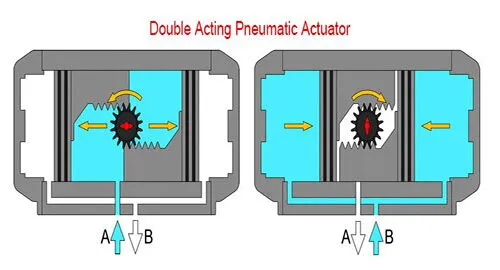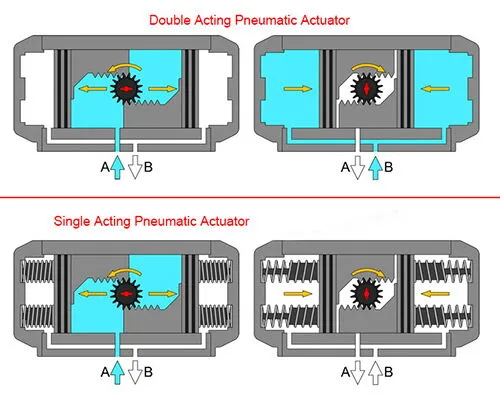Pneumatic Actuators in Control Valves: Single-Acting vs. Double-Acting
On this page
Pneumatic actuators are widely utilized in industrial control valve systems due to their reliability and efficiency, playing a crucial role in automation control. Based on their design structure, pneumatic actuators are divided into two types: single-acting and double-acting. This article delves into the characteristics, applications, and differences between these two types of pneumatic actuators for control valves.
Single-Acting Pneumatic Actuators
Single-acting pneumatic actuators are devices that rely on a pneumatic source to move the piston. When the pneumatic source is connected, the actuator pushes the valve open; when the pneumatic source is disconnected, the actuator automatically resets the valve to the closed position via an internal spring. This automatic reset feature makes them widely used in applications requiring emergency shutdown.

1. Key Features
Automatic Reset: The single-acting pneumatic actuator relies on a spring reset function, automatically closing the valve in case of pneumatic source loss, ensuring system safety.
Energy-Efficient Design: Since pneumatic power is only required to open the valve, the energy consumption of single-acting pneumatic actuators is relatively low.
High Safety: In pipelines transporting flammable gases or liquids, the valve automatically closes when the pneumatic source is lost, greatly reducing potential hazards.
Application Scenarios: Commonly used in systems requiring emergency fluid or gas cutoff, such as petrochemical pipelines, natural gas pipelines, and other industrial control systems.
2. Advantages and Disadvantages
Advantages: Simple operation, easy maintenance, and high safety.
Disadvantages: Limited driving force due to reliance on spring reset, suitable for small and medium-sized valves.
Double-Acting Pneumatic Actuators
Double-acting pneumatic actuators control piston movement through two pneumatic chambers. When one chamber is pressurized, the piston moves in one direction; when the other chamber is pressurized, the piston moves in the opposite direction. This design allows double-acting pneumatic actuators to provide greater thrust and more flexible control.

1. Key Features
Bidirectional Control: The double-acting pneumatic actuator can push and retract the piston through two pneumatic chambers, suitable for applications requiring precise valve position control.
High Thrust: Both pneumatic chambers can provide thrust, allowing double-acting pneumatic actuators to handle larger valves.
Application Scenarios: Widely used in industrial systems requiring precise control, such as automated production lines, hydraulic systems, and large valve control.
2. Advantages and Disadvantages
Advantages: High thrust, precise control, and wide applicability.
Disadvantages: Complex structure, higher installation, and maintenance costs.
Single-Acting vs. Double-Acting Pneumatic Actuators
1. Definition
Single-Acting: Utilizes a pneumatic source to push the piston and a spring to return the piston when the pneumatic source is lost, providing automatic reset.
Double-Acting: Utilizes a pneumatic source to push the piston in both directions, providing bidirectional control.
2. Structure
Single-Acting: Features one pneumatic chamber and an internal spring for return.
Double-Acting: Features two pneumatic chambers, one for pushing the piston and the other for retracting it.
3. Applications
Single-Acting: Suitable for systems requiring emergency fluid or gas cutoff, such as pipeline valves and other control systems.
Double-Acting: Suitable for systems requiring bidirectional control, such as pneumatic-driven pumps, hydraulic systems, and automated production lines.
4. Performance
Single-Acting: Limited driving force, only able to push the piston.
Double-Acting: Greater driving force, capable of both pushing and retracting the piston.
5. Installation
Single-Acting: Simple installation, only requires connection to the valve or other control system.
Double-Acting: More complex installation, requiring connection to two pneumatic chambers and finer tuning.
6. Maintenance
Single-Acting: Less maintenance, simple structure, low failure rate.
Double-Acting: More maintenance, complex structure, requiring regular inspection and upkeep.
Both types of pneumatic actuators have their advantages and disadvantages. Choosing the right actuator depends on the specific application scenario and requirements. Single-acting actuators are suitable for systems requiring high safety and emergency shutdown functions, while double-acting actuators are ideal for industrial systems requiring precise control and high thrust. Understanding their differences and applications helps in selecting the most suitable type of pneumatic actuator for control valves, ensuring system safety and efficient operation.
